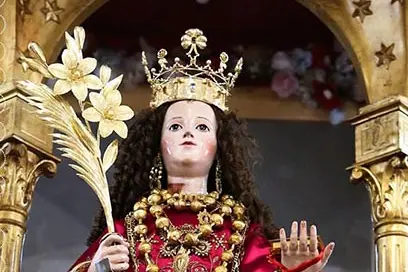Decimomannu and Santa Greca: votive offerings in the Hall of Miracles
Parish Priest Don Andrea Lanero: "This year I remember his intercession for a woman from Quartu and a man from the village."Per restare aggiornato entra nel nostro canale Whatsapp
Some people, like Anna Spada of Decimomannu, have asked for and received a solution to a vision problem, while others, like the parents of Renzo Porta of San Gavino, have prayed for their son to recover from a gastrointestinal illness.
There are many, too many to tell, the miracles that Greca, the patron saint of Decimomannu, has performed and to which those who have received the miracle have responded : the poorest with a prayer vow, a suffrage mass or a wax object, the wealthy with an offering of money, a silver heart or a precious rosary, and the wealthy with objects of great value such as gold jewellery or, until the 1950s, heads of cattle.
Over the centuries, more and more faithful have gathered at the foot of the statue to exchange a votive offering for a promise. And today, behind the door of a bank vault, in special silk-lined wooden boxes, the gold and precious items donated by the faithful to the saint are jealously guarded: this is the so-called "treasure" of Santa Greca. A specially selected portion of this treasure is used to adorn the statue during the rite of investiture. Earrings, necklaces, bracelets, rings, brooches, gold buttons, some embellished with pearls and precious stones, are donated to the saint for graces received (pgr) or for a vow made for graces accepted (vfga).
Part of it was sold in the 1980s by then-parish priest Don Raimondo Podda to raise the funds needed to restore the two churches. Even today, though less frequently, gold and silver objects are donated to the Saint: "The tradition is being lost," said the parish priest of Decimomannu, Don Andrea Lanero, "due to the rising price of gold." And as Don Podda did in his time, it's not out of the question to repeat the sale, subject to cataloging, of the gold that never leaves the bank: "We will propose it to the citizens. The proceeds could be enough to cover the sum the parish would need to donate to build the 'Santa Greca' museum, in addition to municipal and regional funds."
Meanwhile, the 2025 edition of the festival was a resounding success: "If we had used the oratory inn as in previous years, the collection would have been record-breaking," added Father Lanero.
Beyond the gold, there are the votive offerings that adorn the church, whose walls (particularly those of the room adjacent to the sacristy) are literally plastered with silver hearts and naive paintings that represent the kindness received. An example? Silver hearts with eyes engraved on them for those who have regained their sight. Thousands of photographs have been added to these since the advent of photography. There are also more bizarre objects, such as locks of hair, wax reproductions of body parts, crutches, and other devotional materials: all evoking an illness from which one has recovered, an unexpected pregnancy, or a consolation in a time of suffering.
At the beginning of the 20th century, Don Raimondo Maxia was the first parish priest to write about votive offerings, each of which tells a story: "They are scenes of the sick miraculously healed from incurable diseases, poor victims of misfortune miraculously saved from certain death, successful surgical operations, soldiers saved from enemy fire, children freed from fire and other imminent misfortune by the saint's work." Stories of miracles come from all over Sardinia, and even from the mainland: "It's impossible to record them all." However, many are recorded in black and white in the parish bulletin "L'Aurora di Decimo."
For example, in 1890, Paolo Manis of Selargius was saved after invoking Saint Greca when his horse-drawn chariot fell from the Decimo bridge. And again, the difficult surgical operation Mariangela Spiga of Decimo underwent in 1922 went well after she appealed to the saint.
Along with the ancient stories are modern ones, many handwritten by the faithful in a notebook inside the "photo room." "I remember two from this year," said Father Lanero. "The first concerns a woman from Quartu Sant'Elena who was scheduled to undergo bone surgery. After she prayed to the saint shortly before the operation, the x-ray immortalized the miracle, and the operation was no longer necessary. Then there's the story of one of our fellow villagers who fell heavily in the street during the feast. No passerby helped him up, but the saint performed the miracle after being invoked by the man's wife, a staunch supporter of Greca, who was worried about her husband's failure to return home. When the doctors arrived at the hospital, they confirmed that the man had not suffered any bone damage. What did they offer in exchange for the grace received? Only Saint Greca can know."
